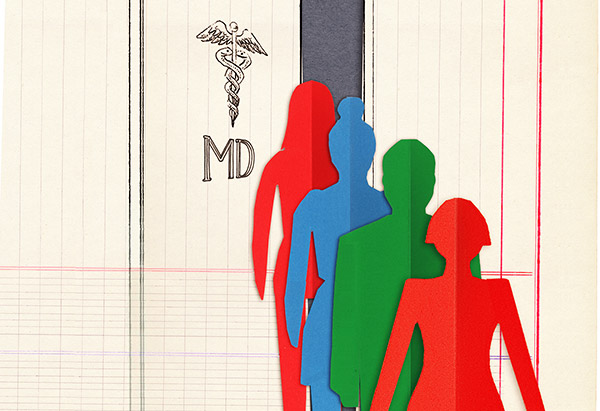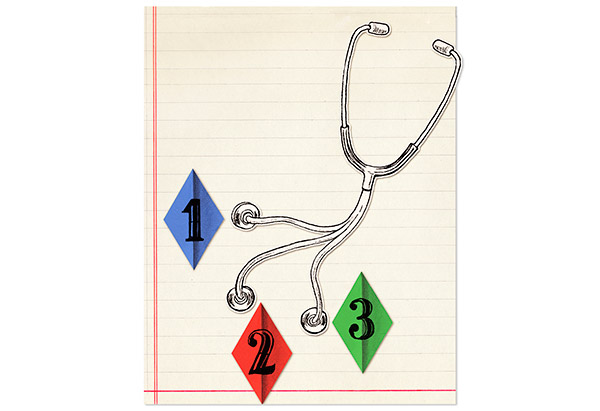We investigate a growing medical trend: shared appointments.

Illustration: Maria Bruni
At 8 a.m. on a crisp fall morning, Allison*, a woman in her late 40s, is bending at the waist in an attempt to touch her toes. Allison suffers from back problems and numbness in her leg, and the doctor wants to see how low she can go before the pain hits; she gets to about midshin and stops. Most days, she says, her discomfort registers an eight out of ten.
Allison has a roomful of observers who feel her pain—almost literally. Around her, in a loose semicircle, are three other patients with back problems awaiting their own turns with the doctor, Terence Doorly, MD. They're all first-time patients of his and have signed up to see him in a group session. They watch as Doorly, an energetic neurosurgeon, tests Allison's reflexes, then pulls up her latest MRI scans and points to the large herniated disk near the base of her spine. They learn, along with Allison, that this is the root of her pain, and that she'll likely need surgery.
As Allison slides off the exam table (fully clothed, in case you're wondering), patient number two steps up. Jack*, who is in his early 70s, was blindsided by sudden pain in his back two weeks ago ("like someone had jabbed a knitting needle into my spine"). Doorly asks Jack about his symptoms, checks his range of motion, and reviews his scans. Prognosis: Jack won't need surgery but will require plenty of physical therapy. "You made out better than poor Allison!" Doorly jokes in his Irish brogue, and even Allison laughs good-naturedly at her worst-case-scenario status. No one seems hesitant about sharing personal information. (Jack remarks that steroid injections have made him gain weight he can't seem to lose; Allison says she's been there, too.) The session goes on for another 40 minutes as patients three and four are examined. Then Doorly wraps up by answering questions about treatment options.
Four years ago, Doorly was the first physician at Mass General/North Shore Center for Outpatient Care in Danvers, Massachusetts, to offer shared medical appointments (SMAs). "At first, I did worry that my bond with patients would suffer," he says. "But not a single person has complained that they didn't get enough time with me. So many people have said, 'I wish I'd been doing this all along.' "
While the concept might sound off-putting—one doctor meeting with up to 16 patients of varying ages at the same time—SMAs are catching on. According to the American Academy of Family Physicians (AAFP), the percentage of its members offering SMAs more than doubled, to nearly 12 percent, between 2005 and 2012. And at the Cleveland Clinic, where nearly 10,000 group appointments have been logged since 2002 (8,600 of them took place within the last three years), satisfaction is high: 85 percent of people who attend one SMA sign up for another.
Next: The surprising perks of the "more-the-merrier" approach
Allison has a roomful of observers who feel her pain—almost literally. Around her, in a loose semicircle, are three other patients with back problems awaiting their own turns with the doctor, Terence Doorly, MD. They're all first-time patients of his and have signed up to see him in a group session. They watch as Doorly, an energetic neurosurgeon, tests Allison's reflexes, then pulls up her latest MRI scans and points to the large herniated disk near the base of her spine. They learn, along with Allison, that this is the root of her pain, and that she'll likely need surgery.
As Allison slides off the exam table (fully clothed, in case you're wondering), patient number two steps up. Jack*, who is in his early 70s, was blindsided by sudden pain in his back two weeks ago ("like someone had jabbed a knitting needle into my spine"). Doorly asks Jack about his symptoms, checks his range of motion, and reviews his scans. Prognosis: Jack won't need surgery but will require plenty of physical therapy. "You made out better than poor Allison!" Doorly jokes in his Irish brogue, and even Allison laughs good-naturedly at her worst-case-scenario status. No one seems hesitant about sharing personal information. (Jack remarks that steroid injections have made him gain weight he can't seem to lose; Allison says she's been there, too.) The session goes on for another 40 minutes as patients three and four are examined. Then Doorly wraps up by answering questions about treatment options.
Four years ago, Doorly was the first physician at Mass General/North Shore Center for Outpatient Care in Danvers, Massachusetts, to offer shared medical appointments (SMAs). "At first, I did worry that my bond with patients would suffer," he says. "But not a single person has complained that they didn't get enough time with me. So many people have said, 'I wish I'd been doing this all along.' "
While the concept might sound off-putting—one doctor meeting with up to 16 patients of varying ages at the same time—SMAs are catching on. According to the American Academy of Family Physicians (AAFP), the percentage of its members offering SMAs more than doubled, to nearly 12 percent, between 2005 and 2012. And at the Cleveland Clinic, where nearly 10,000 group appointments have been logged since 2002 (8,600 of them took place within the last three years), satisfaction is high: 85 percent of people who attend one SMA sign up for another.
Next: The surprising perks of the "more-the-merrier" approach

Illustration: Maria Bruni
"The doctor really opens it up to everyone, asking what they want to know, what health news they've heard but don't quite understand, what they're curious about," says 25-year-old Hannah Kish, of Euclid, Ohio, who went to her first group appointment during high school for an annual wellness visit and has attended two more in the past year. "At my most recent checkup, another patient wanted to know if mammograms were being recommended for women under 40. I hadn't even thought to ask about that, so I was glad she did." It's exactly this sort of information sharing and camaraderie that's attracting doctors to a more-the-merrier approach.
Not all patients are candidates for shared appointments (certain issues, such as an undiagnosed condition that may require extensive tests, might be poorly served in a group setting), but SMAs seem especially useful for those with chronic conditions. Sentayehu Kassa, MD, who offers SMAs for people with diabetes, hypertension, and high cholesterol at a clinic in Dallas, finds that her group patients tend to be more compliant with her instructions than those who see her one-on-one. "I'll ask my diabetic group if they know anyone who's lost a limb from the disease, and they'll say, 'My uncle' or 'My sister,'" Kassa says. "That drives home the importance of keeping blood sugar levels in check and maintaining a healthy diet. It's no longer just a doctor preaching to them—it's real people sharing their stories."
Research bears out the effectiveness of the peer support model: A study in the journal Diabetes Care reported that when some 800 type 2 diabetics were assigned to either group or individual care, those who went to SMAs had lower LDL (bad) cholesterol, blood pressure, and body mass index after four years. "Chronic health conditions come with a great deal of fear, and there's real power in knowing you're not alone," says Reid Blackwelder, MD, president of the AAFP. "You can hear how other people have overcome hurdles you may face."
Of course, skeptics might suspect that SMAs are really just a way for doctors to increase their income. By lumping multiple people into one time slot, doctors can indeed take in considerably more money, with patients coughing up the same co-pay they would if seen privately. According to one study in Group Practice Journal, physicians conducting shared appointments were able to see an average of 41 patients in nearly six hours—25 more than they could see one-on-one. Yet Blackwelder maintains that shared appointments aren't a way to game the system. "They require meticulous planning and allow patients to have more time with a doctor," he says. "The positive outcomes are significant and can make them worth it for both the patients and the practice." And with the Affordable Care Act set to cover 30 million previously uninsured Americans by 2021, SMAs may be exactly what's needed to avoid logjams in waiting rooms. "With decreasing reimbursement and rising overhead costs, group visits may improve a patient's access to care without leaving her feeling shortchanged or rushed through the process," says Doorly.
Alicia Eddy, who had basal cell carcinoma before attending an SMA at Massachusetts' Harvard Vanguard Medical Associates in 2011 with other skin cancer patients, says she only wishes she had heard about the option sooner. "If something like this had been offered when I was younger, I think I would have been more informed and made changes to my skin care earlier," says Eddy, 49. "As much as you can read information packets, nothing beats talking to other people."
Next: What to expect at a shared medical appointment
Not all patients are candidates for shared appointments (certain issues, such as an undiagnosed condition that may require extensive tests, might be poorly served in a group setting), but SMAs seem especially useful for those with chronic conditions. Sentayehu Kassa, MD, who offers SMAs for people with diabetes, hypertension, and high cholesterol at a clinic in Dallas, finds that her group patients tend to be more compliant with her instructions than those who see her one-on-one. "I'll ask my diabetic group if they know anyone who's lost a limb from the disease, and they'll say, 'My uncle' or 'My sister,'" Kassa says. "That drives home the importance of keeping blood sugar levels in check and maintaining a healthy diet. It's no longer just a doctor preaching to them—it's real people sharing their stories."
Research bears out the effectiveness of the peer support model: A study in the journal Diabetes Care reported that when some 800 type 2 diabetics were assigned to either group or individual care, those who went to SMAs had lower LDL (bad) cholesterol, blood pressure, and body mass index after four years. "Chronic health conditions come with a great deal of fear, and there's real power in knowing you're not alone," says Reid Blackwelder, MD, president of the AAFP. "You can hear how other people have overcome hurdles you may face."
Of course, skeptics might suspect that SMAs are really just a way for doctors to increase their income. By lumping multiple people into one time slot, doctors can indeed take in considerably more money, with patients coughing up the same co-pay they would if seen privately. According to one study in Group Practice Journal, physicians conducting shared appointments were able to see an average of 41 patients in nearly six hours—25 more than they could see one-on-one. Yet Blackwelder maintains that shared appointments aren't a way to game the system. "They require meticulous planning and allow patients to have more time with a doctor," he says. "The positive outcomes are significant and can make them worth it for both the patients and the practice." And with the Affordable Care Act set to cover 30 million previously uninsured Americans by 2021, SMAs may be exactly what's needed to avoid logjams in waiting rooms. "With decreasing reimbursement and rising overhead costs, group visits may improve a patient's access to care without leaving her feeling shortchanged or rushed through the process," says Doorly.
Alicia Eddy, who had basal cell carcinoma before attending an SMA at Massachusetts' Harvard Vanguard Medical Associates in 2011 with other skin cancer patients, says she only wishes she had heard about the option sooner. "If something like this had been offered when I was younger, I think I would have been more informed and made changes to my skin care earlier," says Eddy, 49. "As much as you can read information packets, nothing beats talking to other people."
Next: What to expect at a shared medical appointment

Illustration: Maria Bruni
Strength in Numbers
Proof that shared medical appointments (SMAs) really can make a difference.
Blood Pressure
SMA: Decreased by 13.7 mmHg
Non-SMA:: Decreased by 6.4 mmHg
Appointment Wait Time
SMA: 25 days for new bariatric patients
Non-SMA:: 58 days for new bariatric patients
ER and Inpatient Charges for Uninsured Patients
SMA: $250 per patients per month
Non-SMA:: $1,167 per patient per month
Weight Change
SMA: 1 percentage of weight lost
Non-SMA:: .8 percentage of weight lost
Will I have to get naked in front of strangers?
Here's what to expect at a shared medical appointment.
No, other patients won't see you in your skivvies. For appointments that require disrobing (like annual exams or dermatologic skin checks), the doctor sees each patient individually in a private room before the (fully clothed) group session.
There may be men in your session—and possibly people you know. Annual checkups are almost always same sex, but for conditions like diabetes, high cholesterol, or asthma, expect to see both men and women at your appointment. And because the doctor's office can't give you other patients' names ahead of time, it's possible that you'll find yourself in a group with a co-worker or neighbor. If that happens and it's an issue, you can reschedule.
What happens in the room stays in the room. Before a session begins, patients must sign confidentiality forms.
Your co-pay won't increase. Even though you'll likely spend at least triple the time with your doctor compared with a one-on-one session, SMAs are billed the same; your out-of-pocket costs won't change.
More Ways to Get the Most Out of Next Checkup




